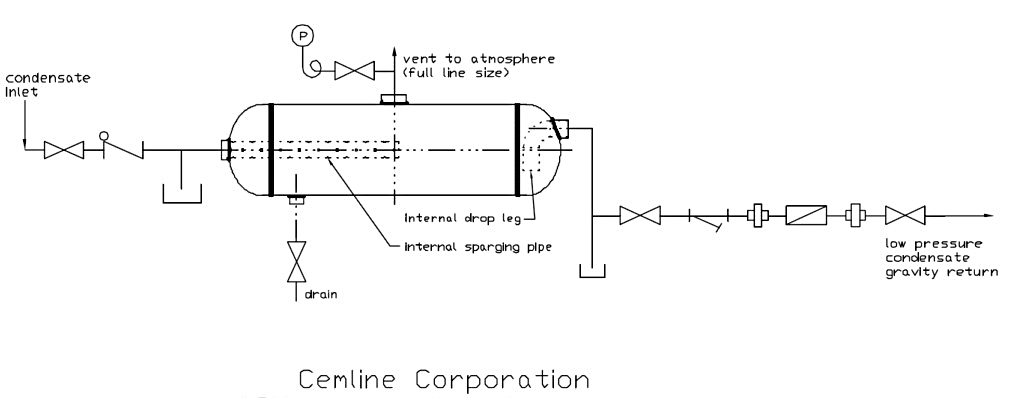Steam Basics Part 19: Medium and High Pressure Steam Vented Flash Tank Trim
/By Chad Edmondson (JMP) and Norman Hall (RLD)
In our last blog we described the difference between horizontal and vertical high-pressure condensate flash tanks. Once a decision is made between the horizontal and vertical orientation, the engineer must select the trim and show the installation detail.
Vertical Vented Condensate Flash Tanks
In the example below, a Cemline model H80FST flash tank was selected by the online sizing program.
SPECIFICATION OPTION 1: The tank has a 150 PSIG working pressure and carries the ASME label, which is critical for pressure vessels within commercial and institutional buildings. This is listed as an option but may be required by most codes and is strongly recommended.
SPECIFICATION OPTION 2: Notice the drawing shows an inlet sparge tube. A sparge tube is a piece of pipe with multiple holes precisely drilled to allow the condensate to enter under the water across the length of the tank. This gives an even distribution of both the condensate and the flash steam within the tank. Be sure your specification includes this.
SPECIFICATION OPTION 3: The right side of the drawing shows a drop leg for the outlet of the cooled condensate. The condensate outlet is located above the inlet to provide a water level, that insures that the condensate always enters below the water line. Without a drop leg, the water leaving the tank would be very hot, as it would trickle out at the flash steam to water barrier. The drop leg assures that the condensate leaving the tank is cooler. This protects the low-pressure return system from excessive flash steam that the return line may not be sized to handle.
SPECIFICATION OPTION 4: The drawing below also shows a handhole for inspection and clearing of debris. The handhole is not available on very small tanks. I rarely use this option since the tank is rarely inspected, if at all.
Vertical Vented Condensate Flash Tanks
Horizontal flash tanks use a different operating principle, which limits the trim options.
SPECIFICATION OPTION 1: These tanks should also carry the ASME label as mentioned above.
SPECIFICATION OPTION 2: Vertical tanks operate on the centrifugal action caused by the tangential inlet. This inlet is critical to the correct operation and separation of steam and condensate. As hard as it is to believe, some lower priced manufacturers will provide a vertical tank without this key option. Make sure you specify it and get it on your flash tanks.
SPECIFICATION OPTION 3: The installation of these tanks requires some sort of structure to hold them. Since this is an ASME tank with a National Board number, the average welder cannot simply weld supports to the tank without voiding the ASME label and associated insurance. Support legs are provided when specified, so the engineer should make sure the drawings detail the legs. The height of the legs in this example is 10” and the steam float and thermostatic trap must be located below the outlet. If additional height is needed, the engineers can work with their local representative to make sure the CAD drawing and specification align to these needs.
Vented Steam Flash Tank Installation
The installation drawings for both tanks are shown above. The outlet float and thermostatic traps should refer to your standard details. There should be 14” of pipe below the outlet if your selections are based on ½ PSIG trap pressure drop. This can be adjusted as described in earlier blog articles. The vent size is critical; the vent should be sized for 4000 FPM velocity or less. Now, let’s look at that pressure gauge.
Pressure gauges for Steam Systems
The pressure gauge should have a pigtail syphon and a shutoff valve. The specification for installation should instruct the contractor to fill the pigtail with water before installing the gauge. Many low-priced pressure gauges are available in the market, but we prefer to spend a little more on steam gauges for longevity and safety. Miljoco, a gauge manufacturer located in Mt. Clemens, Michigan, offers a great process gauge for steam—model P4520L. It’s 4-1/2” with 426 stainless steel internals and ½% accuracy. It has a propylene case and a solid front with a blowout back for safety. NEVER USE LIQUID FILLED GAUGES ON STEAM!
The Cemline program automatically selects the correct tank size and opening sizes required AND provides you with a CAD-ready drawing. If you would like to sign up for the Cemline sizing program, just visit this resource page on the manufacturer's website.






